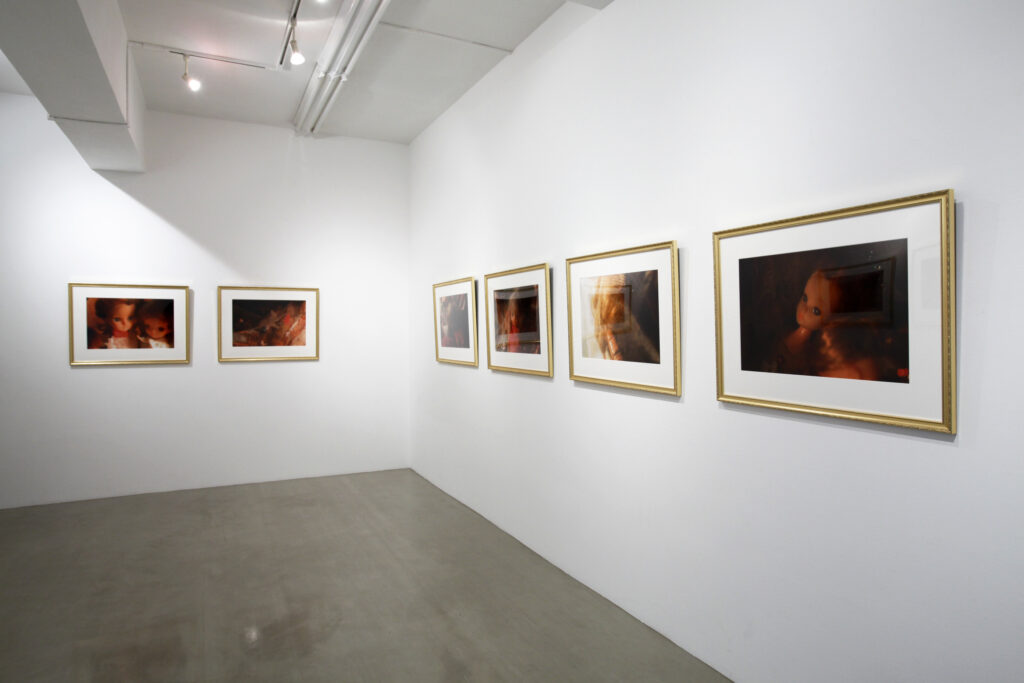
【文/宮田徹也】
そもそも現代美術と写真は、その誕生の時期を同じにしている。それにも関わらず、写真は芸術ではないと考えられてきた。その理由とは、現代美術さえも逃れられない資本主義の潮流に、写真が初めから関連したことが一つの要因であると考えることができよう。当然、写真が持つ特徴とはそれだけでは済まされないのだから、今日の国際展に限らず現代美術の活動の場で写真作品は重要な位置を占めている。しかし、写真の持つ芸術性の本質を見抜き、その特性の探究を行った哲学者はW・ベンヤミン(『写真小史』1931年)、S・ソンタグ (『写真論』1977年)と枚挙に暇がない。今回、古賀亜希子の写真作品を語るために、R・ バルト『明るい部屋』(1980年)を援用する。
古賀は1979年福岡生まれ、2004年に東京綜合写真専門学校を卒業、2009年まで各地で個展を開催してきた(08年を除く/グループ展も多数)。四年ぶりとなる今回の個展で古賀は、自己が幼少の頃使用していた人形を実家で仕舞われている状態で撮影し、370×550mmで印画紙にデジタルプリントした10点を展示した。人形が、静謐な空間を守っている。時間は止まっていない。現在進行形であるどころか、未来からやってきているように見える。何故 か。 R・バルトは言う。「「写真」が数限りなく再現するのは、ただ一度しか起こらなかったことである。「写真」は、実際には二度とふたたび繰り返されないことを、機械的に繰り返す。「写真」に写っている出来事は、決してそれ以外のものに向かって自己を乗り超えはしない」。機械的、は、機械が写すという意ではない。一度しかないことを感情のないまま繰り返すことを示す。何故、写真には感情が失われるのか。R・バルトは次のように説明す る。「結局のところ私が、私を写した写真を通して狙うもの(その写真を眺める際に《志向するもの》は、「死」である」。写真を眺めることは、写真から読み取る事項は死であるという。死に感情は存在しない。しかし写真を撮る/見ることの間に隔てはなく、誰もが避けら れない事実が浮彫となる。「狂気をとるか分別か。「写真」はそのいずれをも選ぶことがで きる。「写真」のレアリスムが、美的ないし経験的な習慣に弱められ、相対的なレアリスム にとどまるとき、「写真」は分別あるものとなる。そのレアリスムが、絶対的な、もしこう言ってよければ、始源的なレアリスムとなって、愛と恐れに満ちた意識に「時間」の原義そのものをよみがえらせるなら、「写真」は狂気となる。つまりそこには、事物の流れを逆にする本来的な反転運動が生ずるのであって、これを写真のエクスタシーと呼ぶことにしたい」。
古賀の写真にはエクスタシーがある。否、それどころか、R・バルトは「写真には未来がな い」と述べている。同時に、「公表された写真を読み取るときも、結局つねに私的な読み取りがおこなわれている」ことを指摘している。古賀の作品に、これが存在しない。私的な要素を見る者が読み取ることが許されず、作品の内部には未来が満ち溢れているのである。これはどういうことか。
古賀は自らの視線を徹底的に個人化することによって、個人という者を喪失する。そのた め、撮る/見るという行為自体が失われていくのだ。古賀の作品を眼にすると、次々に砂塵の如く、作品の表情は消えていく。そこに立ち表れるものは、未来に存在するという現代美術がもつ姿なのだ。
宮田徹也(日本近代美術思想史)
Licca
MIYATA Tetsuya/Researcher of Modern Japanese Art and Intellectual History
The period in which “contemporary art” and “photography” came into existence is the same. Despite this, photography had not been considered an artistic genre for a long period of time. One of the primary factors behind this is that photography from its initial stage has been connected with the rise of capitalism, which was unescapable even for the contemporary art world. Needless to say, since that element could not be the only attribute of photography, photographic works have come to hold a prominent position in international art exhibitions of today, as well as in sites of contemporary art activities. There have also been many specialists who saw the true artistic essence of photography and examined its attributes, such as the philosopher Walter Benjamin (A Short History of Photography, 1931), and critic Susan Sontag (On Photography, 1977). In discussing Koga Akiko’s photographic works in this essay, I will employ quotes from Roland Barthes’ book Camera Lucida (1980).
Koga was born in 1979, and graduated from the Tokyo College of Photography in 2004. She held solo shows every year up to 2009 (except 2008), and also participated in many group exhibitions. For this exhibition, which was her first solo show in four years, she photographed the dolls she played with as a child. The photos of the dolls were taken in their tucked-away positions at her parents’ house. She exhibited ten digital prints on photographic paper, each 370 x 550 mm in size. The dolls in her photos maintain the tranquil sense of the space, while also conveying a feeling as if time was still ticking. The dolls not only seem to exist in the present but also seem to have come from the future. Why is this? I will refer to Roland Barthes’ comment:
The first thing I found was this. What the Photograph reproduces to infinity has occurred only once: the Photograph mechanically repeats what could never be repeated existentially. In the Photograph, the event is never transcended for the sake of something else.
The word “mechanically” does not refer to a photo taken with a machine, but signifies an emotionlessly repeated reproduction of a photo that derives from a one-time occurrence. Then, one may ask, why is a photo deprived of emotions? Barthes elucidates on this when he says, “Ultimately, what I am seeking in the photograph taken of me (the ‘intention’ according to which I look at it) is Death…” This means that “looking at a photo” and “what one reads from a photo” amount to death. Death has no emotions. There is no distinction between “taking” and “viewing” a photo; rather, it manifests the fact that death is unavoidable to all. Barthes also comments on this idea as follows:
Mad or tame? Photography can be one or the other: tame if its realism remains relative, tempered by aesthetic or empirical habits (…); mad if this realism is absolute and, so to speak, original, obliging the loving and terrified consciousness to return to the very letter of Time: a strictly revulsive movement which reverses the course of the thing, and which I shall call, in conclusion, the photographic ecstasy.
Koga’s photography has that ecstasy. Not only does Barthes’ quote above reflect this, but he goes so far as to say, “…it [photography] is without future…” He also indicates,
“The reading of public photographs is always, at bottom, a private reading.” But this essence does not exist in Koga’s works, as the viewers are withheld from “a private reading.” And the inside of her works is filled with a feeling of the future. What does this mean?
Koga thoroughly individuates her own view to the point of banishing her individual being. This is why the acts of “photographing” and “viewing” are removed from her works. What manifests through her process is the appearance of contemporary art that exists in the future.
(Translated by Taeko Nanpei)

